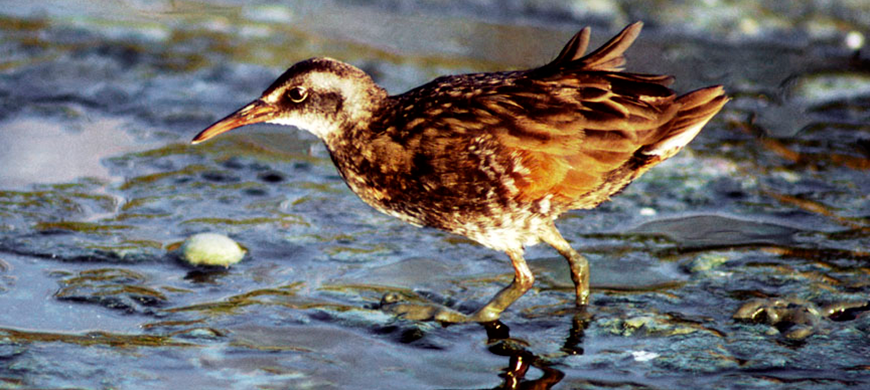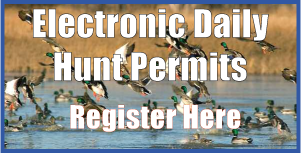Rail

To buy a HIP Stamp, CLICK HERE.
Virginia rails and soras are the two rail species that can be hunted in Kansas. These species prefer wetlands with dense stands of cattail and bulrush for nesting, but frequently are found in higher-elevation portions of wetlands where grass or other less-robust vegetation is shallowly flooded. Virginia rails and soras nest in Kansas. During the nesting season, they primarily consume aquatic insects and other aquatic invertebrates. Seeds and animal matter are eaten in late summer and fall.
Rails typically are hunted in combination with snipe in the same habitats. Rails can use deeper water than snipe, but also are found in shallow water and on mudflats. Because seeds are an important part of the diet in late summer and fall, shallow-water areas with dense stands of seed-producing plants are prime rail hunting areas. Although rails don’t fly nearly as fast and evasively as snipe, hunting both snipe and rails together is like trying to adjust to a baseball pitcher’s fastball and changeup. Rails also compensate for their relatively slow flight by not remaining aloft for long.
Rail hunters need to be proficient in identification of the other look-alike species found in rail habitat. King, black, and yellow rails also occur in Kansas, but they aren’t legal to hunt. Of these nongame rails, kings are the most common and the others aren’t likely to be encountered when hunting. The king rail is similar in shape to the Virginia rail, but kings are about twice as large as Virginias.
To purchase your HIP Stamp online, CLICK HERE.
Migratory Game Bird Hunters – Why is it important to be “HIP”?
If you hunt doves, ducks, geese, sandhill cranes, coots, snipe, rail, or woodcock, you are required to participate in Harvest Information Program (HIP).
What is HIP?
Harvest Information Program (HIP) is a method by which state wildlife agencies and the U.S. Fish and Wildlife Service (USFWS) use to provide reliable estimates of the number of migratory game bird hunters, hunter activity and migratory game bird harvest. These estimates provide information needed to make sound decisions concerning hunting seasons, bag limits, and population management. HIP has been a federal requirement of those hunting migratory game birds since 1998.
Who needs to be HIP?
HIP, incorrectly, has become associated more closely with waterfowl hunters. HIP applies to all those who hunt any species of migratory game birds. This would include not only ducks and geese but also doves, woodcock, rails, snipe, sandhill cranes, moorhens, band-tailed pigeons, swans, brant, coots and gallinules, for which there is a set hunting season. If you are required to buy a Kansas hunting license and plan to hunt any migratory game birds in Kansas, you are required to acquire a Kansas Harvest Information Program (HIP) permit. Even if you hold a lifetime license, you still are required to acquire a HIP permit. Exemptions from HIP include those not required to have a Kansas hunting license such as people hunting their own land and residents 15 and younger and 75 and older. It is the hunter responsibility to fulfill their HIP requirement. Proof of HIP must be carried with the hunter in the field, and, like a hunting or fishing license, must be presented to a wildlife officer upon their request. Hunting migratory birds without HIP certification is like hunting without a license—you could be ticketed or fined. You must be HIP certified for each state for which you hunt migratory game birds. The HIP certification process varies from state to state. Please confer with your local wildlife agency regarding HIP in their state.
How does HIP work?
When you purchase your Kansas HIP permit, you first are identifying yourself as migratory game bird hunter. Secondly, the licensing vendor will ask you a series of short questions relating to your hunting experience during last year's season. These questions place you in a sampling stratum from which the USFWS selects small sample to complete a more detailed survey about this year’s upcoming hunting season. These short questions that you are asked about last year’s hunting experience when you become HIP-certified are not part of the survey, and are not used to compile harvest estimates, but are simply used to identify what types of birds you usually hunt. This allows the USFWS to target its surveys to the appropriate hunters. For example, most surveys about dove harvest are sent to hunters who usually hunt doves, while most waterfowl harvest surveys are sent to hunters who usually hunt ducks and/or geese. If you only hunt ducks and geese – no snipe or rails, no moorhens or gallinules – why is it that I have to answer questions about those species? The USFWS needs to be able to contact people who hunt various birds. This narrows the field and allows the USFWS to ask more detailed questions about what was harvested.
If your name is one of the few selected for the national harvest survey, you will receive a personal letter and a hunting record form and will be asked to voluntarily keep a record of the number of migratory birds you harvest during the season. You will be given an addressed, postage-paid envelope to return your hunting form at the end of the season. This survey provides the information used to develop nationwide harvest estimates for all migratory birds. A few select participants are asked to send in wings of migratory game birds they harvest to help determine species, age, sex, and other important harvest data. All HIP responses are kept strictly confidential and are not used for any other purpose. As soon as the survey is completed, the USFWS destroys all hunter names and address records.
As HIP information is gathered at the time a hunting license is purchased whether at a store or online. At the license counter, the license agent should ask the HIP questions as part of the licensing process; if they do not inquire, you should remind them of HIP’s requirement. Kansas charges a small fee to cover administrative costs. KDWP or USFWS receives no income from this program. HIP is strictly to gather information and is not a means of raising money for conservation programs.
What do hunters gain from HIP?
An understandable question is ‘What does HIP mean to me, as an individual asked to participate in this annual series of inquiries?’ The vast majority of hunters who participate are doing so because they know it’s important and understand why it’s important as hunters. Hunters are not just people answering a survey but are partners in data collection that directly affects hunting opportunities. As the threats and concerns for migratory bird populations continue to mount, it is essential to gather the best information possible about the factors affecting these populations. It is in the hunter's best interest to have wildlife management decisions based on scientific evidence, not on opinions, philosophies, or politics. It only takes a few moments to give wildlife managers the information they need to ensure that our migratory bird resources--and hunting tradition--will be around for future generations to enjoy.
To Purchase Your Kansas HIP Permit Online: https://license.gooutdoorskansas.com
For More Information
USFWS HIP: https://www.fws.gov/birds/surveys-and-data/harvest-surveys/harvest-information-program.php
USFWS Harvest and Hunter Survey Annual Reports: https://www.fws.gov/birds/surveys-and-data/reports-and-publications/hunting-activity-and-harvest.php
Explore Harvest Data visualization for your region: https://fws.gov/harvestsurvey/harvest-vis
Central Flyway Council: https://centralflyway.org/management/harvest-surveys/








